Transform Your Home: The Ultimate Guide to Stone Front Porch Ideas for Lasting Curb Appeal
Is your home’s exterior lacking that touch of warmth and elegance? Imagine stepping onto a beautiful, inviting front porch that not only welcomes guests but also significantly boosts your property’s curb appeal. For many homeowners, including myself, the journey to a more charming entrance often leads to one timeless material: stone. Adding a stone porch can truly transform the entire facade of your house, creating a sophisticated and enduring statement.
Whether you’re drawn to the rustic charm of natural flagstone, the subtle elegance of limestone, or the sleek sophistication of polished granite, stone offers unparalleled versatility. It’s more than just an aesthetic choice; stone provides exceptional durability, withstands various weather conditions, and introduces a rich texture that beautifully integrates your home with its natural surroundings. It instantly elevates the perceived value and character of your property.
In this comprehensive guide, we’ll delve deep into the world of stone front porch ideas. We’ll explore various types of stone, essential design elements to consider, and present a gallery of inspiring ideas to spark your creativity. Furthermore, we’ll equip you with practical advice on how to select the perfect stone for your unique home and maintain its beauty for years to come. Get ready to design a welcoming entrance that leaves a lasting impression!
Types of Stone for Front Porches: Finding Your Perfect Match
Choosing the right type of stone is fundamental to achieving your desired aesthetic and ensuring longevity for your front porch. Each stone possesses unique characteristics in terms of appearance, durability, and maintenance. Here are some of the most popular options for creating stunning stone porches:
- Flagstone: Renowned for its irregular, flat pieces, flagstone offers a distinctive rustic and natural aesthetic. Its earthy tones, ranging from reds and browns to blues and grays, make it perfect for creating an organic, welcoming feel, especially on larger porch surfaces or winding pathways. It’s highly durable and slip-resistant, making it a safe and beautiful choice for any climate. Flagstone is ideal for homeowners seeking a charming, old-world, or cottage-style look, seamlessly blending with natural landscapes.
- Limestone: This sedimentary rock is celebrated for its subtle simplicity and uniform appearance. Available in a spectrum of soft, neutral colors—from creamy whites to light grays and tans—limestone provides an elegant and sophisticated base. It’s particularly well-suited for traditional, Mediterranean, or coastal-inspired architectural styles, offering a classic appeal that is both understated and luxurious. While durable, it’s softer than granite and may require regular sealing to protect against stains and weathering, preserving its pristine look.
- Granite: For those desiring a sleek, modern, and incredibly durable surface, granite is an excellent choice. This igneous rock is one of the hardest natural stones available, making it highly resistant to scratches, heat, and moisture. Its crystalline texture and diverse color patterns—from speckled grays and blacks to vibrant reds and greens—add a touch of grandeur and sophistication. Granite is ideal for contemporary designs or high-traffic areas where longevity and minimal maintenance are priorities, offering a robust and elegant solution.
- Stacked Stone: This refers to a specific application where individual stone pieces are stacked horizontally, creating a textured, multi-dimensional surface. It can be made from various natural stones like slate, quartzite, or sandstone. Stacked stone is commonly used for accent walls, columns, or fireplace surrounds on porches, adding significant visual interest and depth. It excels in rustic, traditional, or even modern designs where a strong textural element is desired, offering a robust and earthy look that stands the test of time.
- Stone Veneer: An increasingly popular option, stone veneer provides the authentic look of solid stone without the prohibitive weight or cost. It consists of thin slices of natural stone or manufactured concrete products molded to resemble natural stone. This versatility allows for a wide range of colors, textures, and styles, mimicking everything from rugged fieldstone to refined cut stone. Stone veneer is an excellent choice for accentuating foundational elements, column wraps, or entire porch walls, offering a cost-effective yet visually impactful solution that’s easier to install and maintain.
Essential Stone Porch Elements to Consider for a Cohesive Design
Beyond the primary stone surface, several other elements contribute to the overall appeal and functionality of your stone front porch. Thoughtful integration of these components can elevate your porch from merely functional to truly extraordinary, enhancing its character and creating a welcoming atmosphere.
- Pillars and Columns: Stone pillars and columns are architectural focal points that lend grandeur and stability to any porch. Whether you opt for robust, stately columns clad in meticulously cut stone, or a more organic look with dry-stacked stones, these elements can define your porch’s style. They offer an opportunity to showcase different stone textures—from smooth, polished finishes to rugged, textured surfaces—that complement the main stone flooring or walls, providing structural support with significant visual impact and curb appeal.
- Steps and Pathways: The journey to your front door begins with the steps and pathways. Extending the stone theme to these areas creates a seamless and inviting transition. Stone steps, whether wide and sweeping or narrow and intimate, instantly elevate curb appeal. Integrating a matching stone pathway that leads visitors gracefully to your porch unifies the entire landscape design and ensures a cohesive aesthetic from the street to your front door. Consider how the texture and color of the pathway stone can complement or contrast with the porch stone for added visual interest and an engaging approach.
- Lighting: Strategic outdoor lighting is crucial for both safety and ambiance. Well-placed lighting can dramatically enhance the beauty of your stone porch after dusk, highlighting its textures and colors while creating a warm, inviting glow. Options include subtle recessed lighting in steps, elegant wall sconces flanking the doorway, or landscape lighting that illuminates surrounding greenery and accentuates stone features. Effective lighting transforms the porch into a functional and beautiful space for evening enjoyment and adds a layer of security.
- Furniture and Decor: Selecting the right porch furniture is key to creating a comfortable and stylish outdoor living area. Choose durable, weather-resistant pieces that complement the natural beauty of the stone. Materials like sturdy wood, sleek metal, classic wicker, or even upholstered outdoor fabric can work harmoniously with stone, offering comfort and style. Add decorative elements such as throw pillows, outdoor rugs, and decorative planters to introduce pops of color and personality, making the space feel more like an extension of your indoor living area.
- Landscaping and Greenery: The surrounding landscape plays a vital role in softening the hard lines of stone and infusing vitality into your porch design. Incorporate stone planters filled with colorful flowers or lush greenery to create natural accents. Flower beds and strategically placed shrubs or small trees can frame your porch beautifully, adding a vibrant touch and integrating the stone structure with its garden setting. The contrast of soft foliage against rugged stone creates an appealing balance and enhances the overall organic feel, creating a harmonious outdoor environment.
Inspiring Stone Front Porch Ideas to Elevate Your Home’s Aesthetic
Ready to envision your dream entryway? Here’s a collection of diverse stone front porch ideas designed to inspire, offering a range of styles from ruggedly rustic to elegantly modern. Each concept leverages the unique qualities of stone to create a truly inviting and memorable first impression for your home.
1. Rustic Flagstone Path
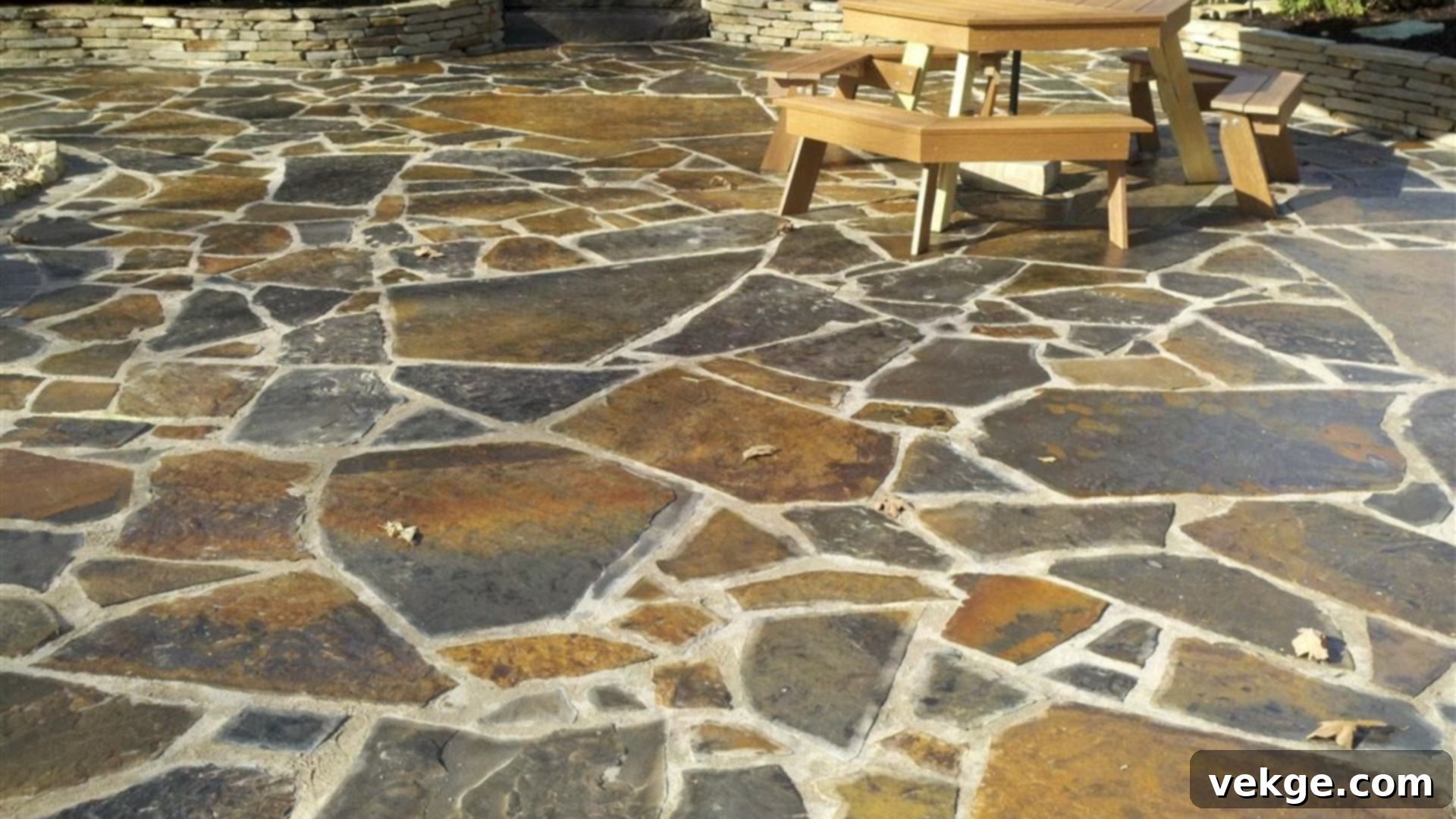
Embrace the beauty of nature with a rustic flagstone path that meanders gracefully towards your porch. The irregular shapes and varied textures of flagstones create an organic, inviting walkway, offering a charming, earthy feel. This style is perfect for homes with a natural, garden-centric aesthetic, enhancing curb appeal by seamlessly blending the hardscaping with the surrounding softscaping, creating a harmonious and welcoming approach.
2. Stacked Stone Columns

Elevate the structural integrity and visual weight of your porch with sturdy stacked stone columns. These robust architectural features provide a timeless, traditional, or even contemporary look, depending on the stone type and stacking method. They not only offer essential support but also add significant character and a sense of permanence to your entryway, creating a grand and inviting statement that anchors the porch visually to your home’s foundation.
3. Stone Veneer Accent Walls
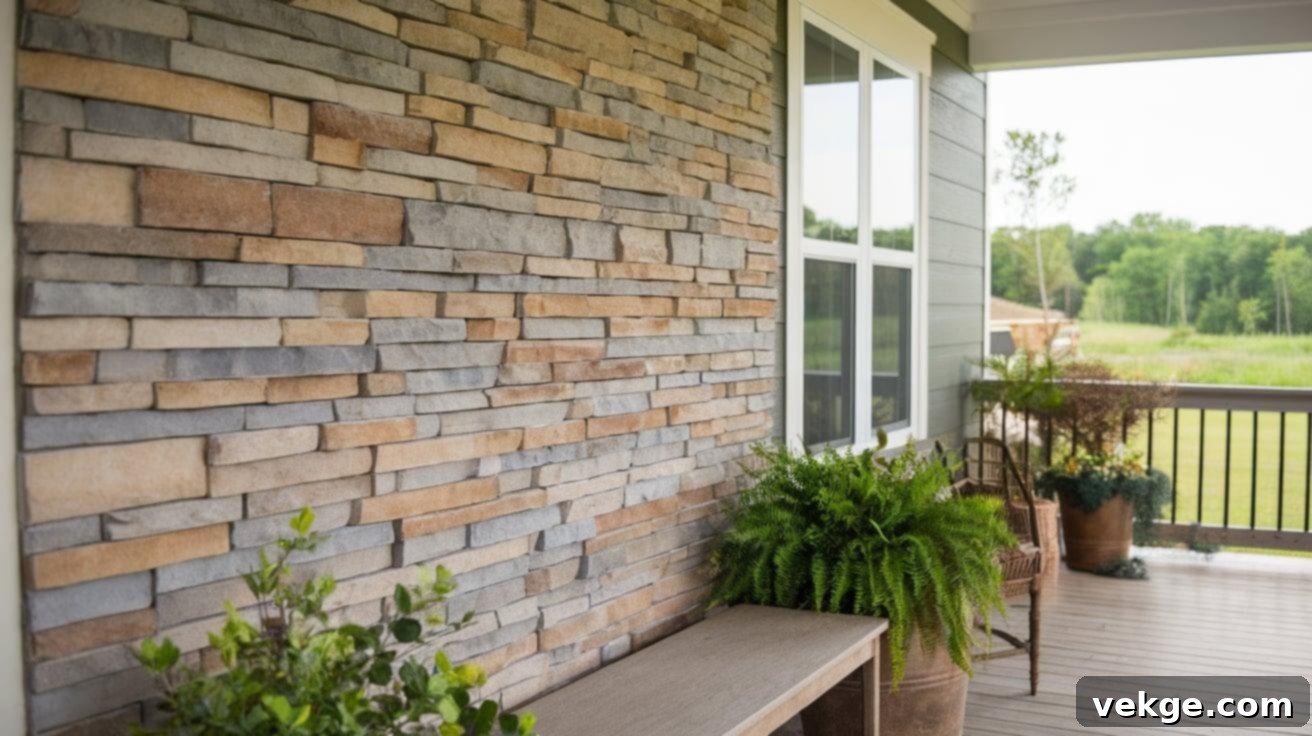
Utilize stone veneer to create stunning accent walls on your porch. This cost-effective and versatile option adds immediate texture, depth, and visual intrigue without the weight or extensive labor of full-sized stone. Stone veneer can mimic various natural stone looks, making it ideal for enhancing your porch’s aesthetic, defining distinct areas, and creating a focal point that is both beautiful and remarkably low-maintenance, offering a dramatic visual upgrade.
4. Mediterranean-Inspired Porch
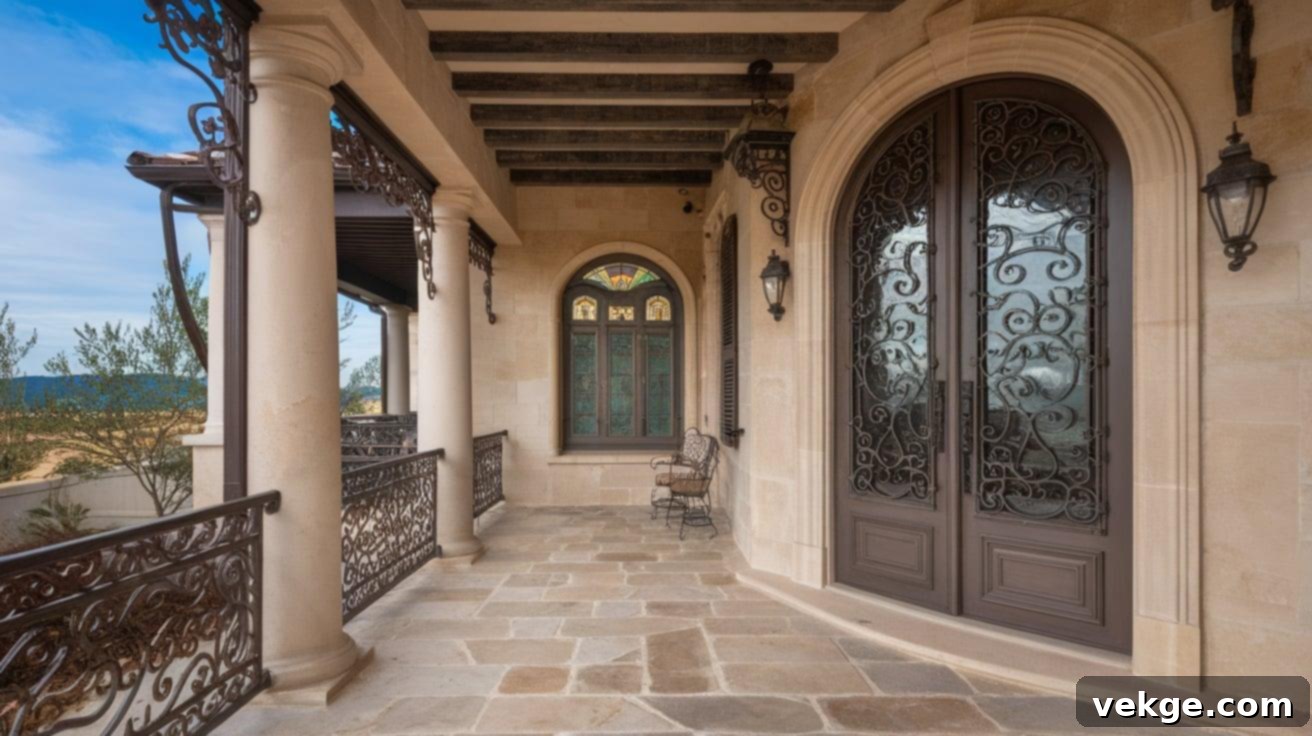
Infuse your entryway with the sun-drenched elegance of a Mediterranean-inspired porch. Combine the subtle sophistication of limestone flooring with ornate wrought iron railings, balustrades, or furniture. Add terracotta planters brimming with vibrant bougainvillea or fragrant herbs to complete the look. This design choice creates a luxurious, welcoming atmosphere reminiscent of a European villa, perfect for adding a touch of romance and regality to your home, making every entrance feel like a grand occasion.
5. Polished Granite Steps
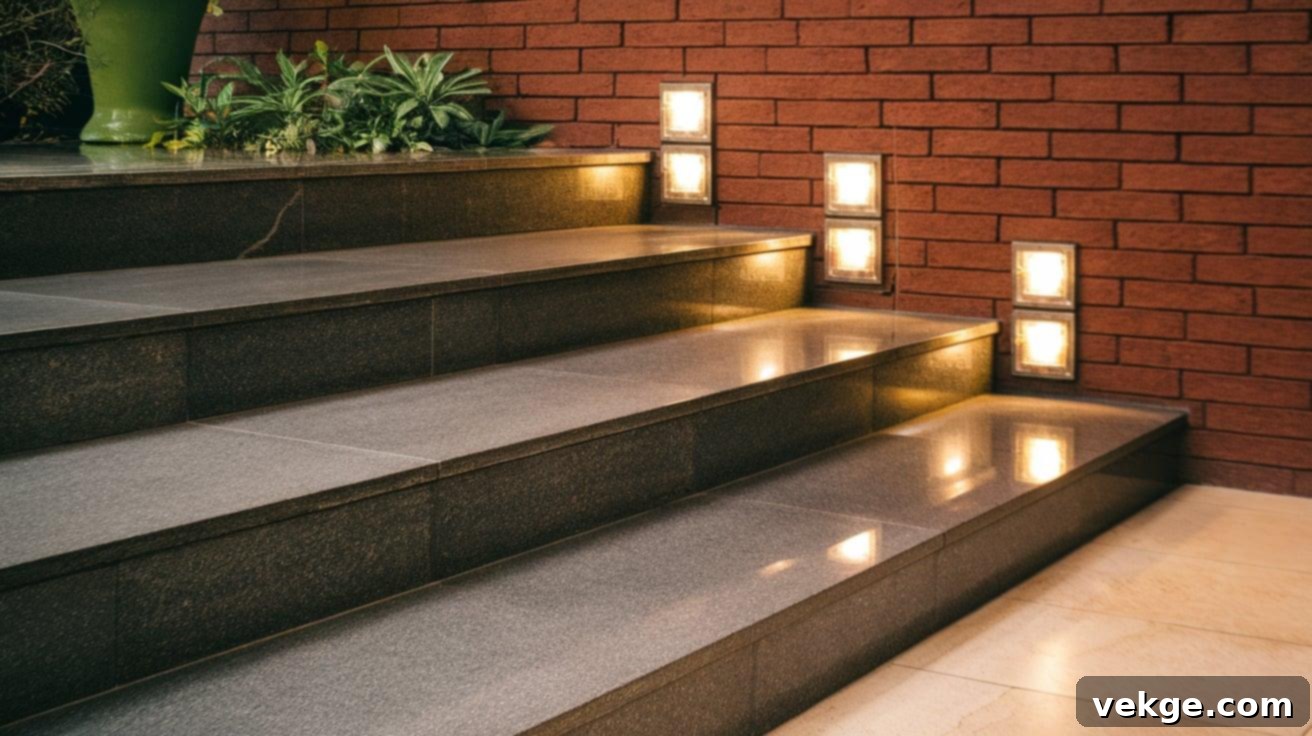
Opt for highly polished granite steps to create a truly sleek and modern entrance. Granite’s exceptional durability ensures these steps will withstand heavy foot traffic and harsh weather, maintaining their pristine appearance for decades. The smooth, reflective surface of polished granite adds a remarkable touch of sophistication and contemporary elegance, making a bold statement of refined taste right at your front door, offering both beauty and unmatched longevity.
6. Wide Stone Steps with Integrated Planters
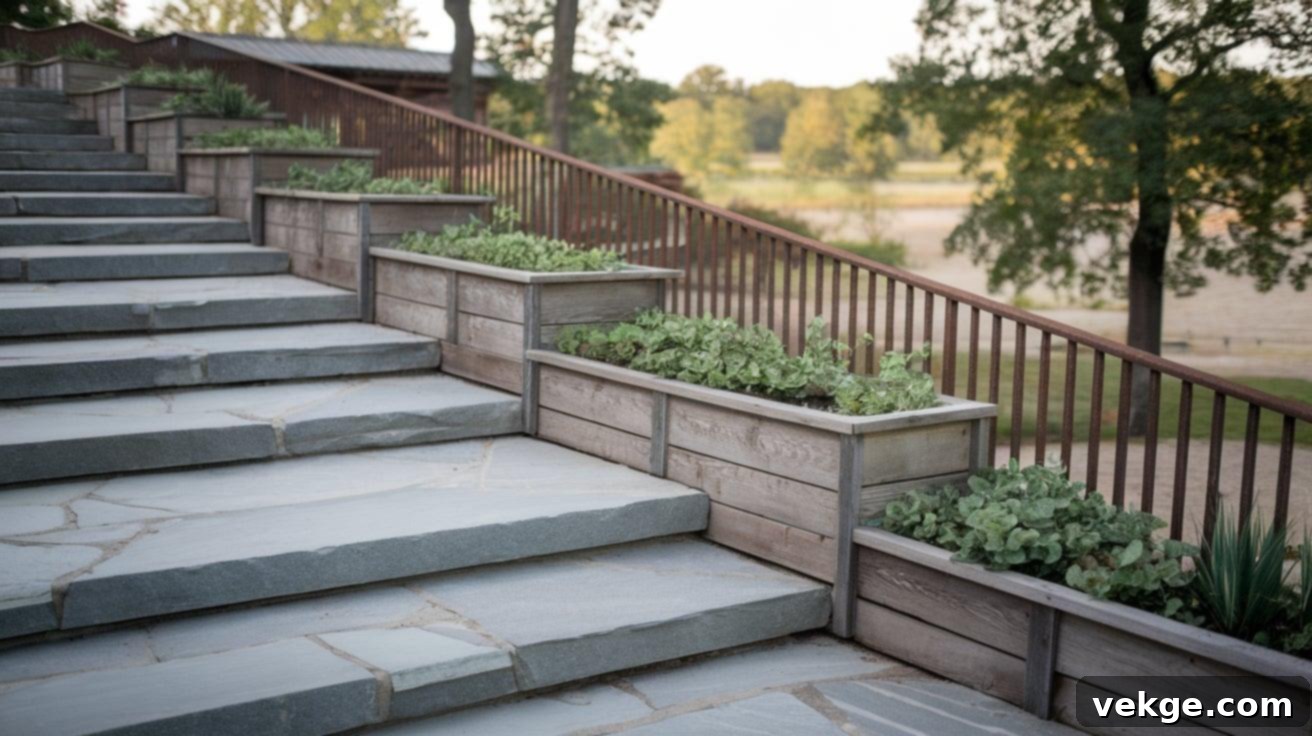
Design a grand and exceptionally welcoming entrance by incorporating wide stone steps flanked by integrated, built-in planters. This combination seamlessly blends functionality with natural beauty. The expansive steps provide a comfortable approach, while the planters, filled with colorful flowers or lush cascading greenery, soften the stone’s edges and add a vibrant, living element to your porch, enhancing both visual appeal and environmental harmony, creating an immediate sense of arrival.
7. Rustic Stone Fire Pit on the Porch
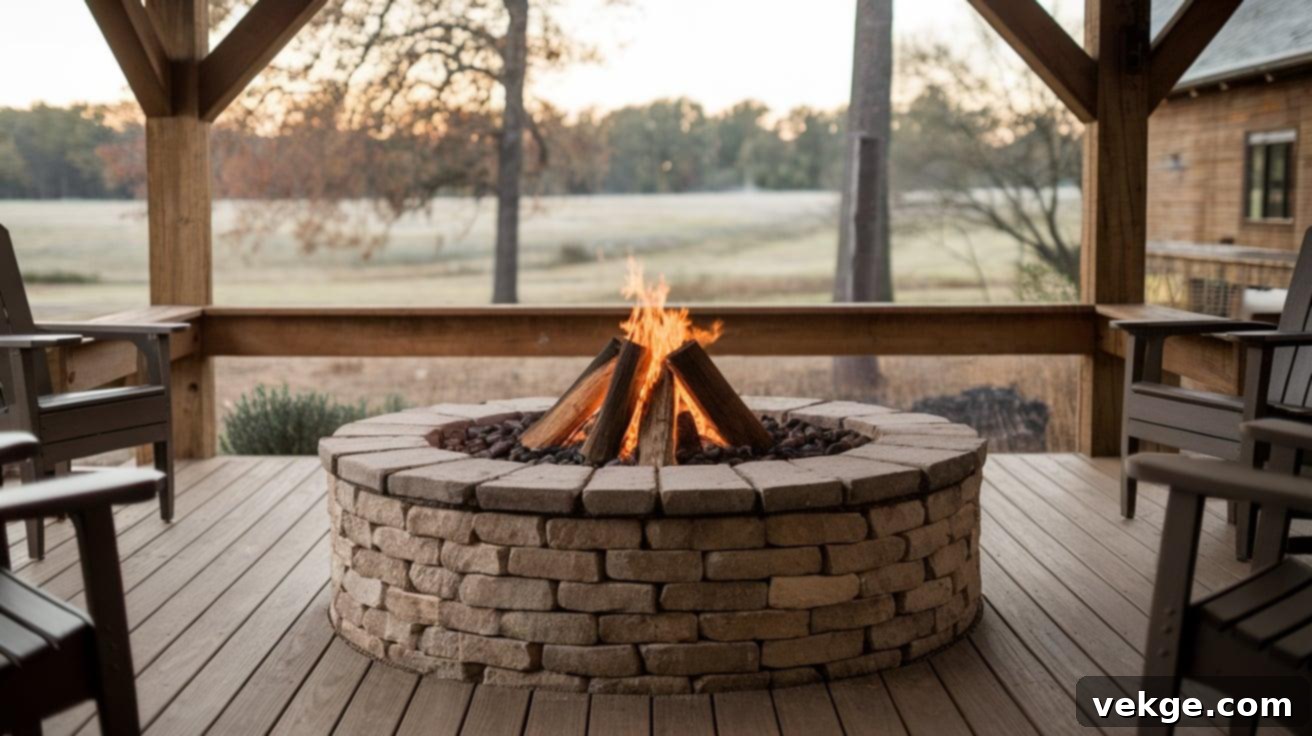
Transform your porch into a true outdoor living room by centering it around a rustic stone fire pit. This inviting feature becomes an instant focal point, encouraging relaxation and social gatherings. The warmth of the fire, encased in natural stone, creates an unparalleled cozy ambiance, making your porch a cherished spot for evening conversations and marshmallow roasts, extending the usability of your outdoor space well into cooler seasons and enhancing family moments.
8. Circular Flagstone Patio Seating Area
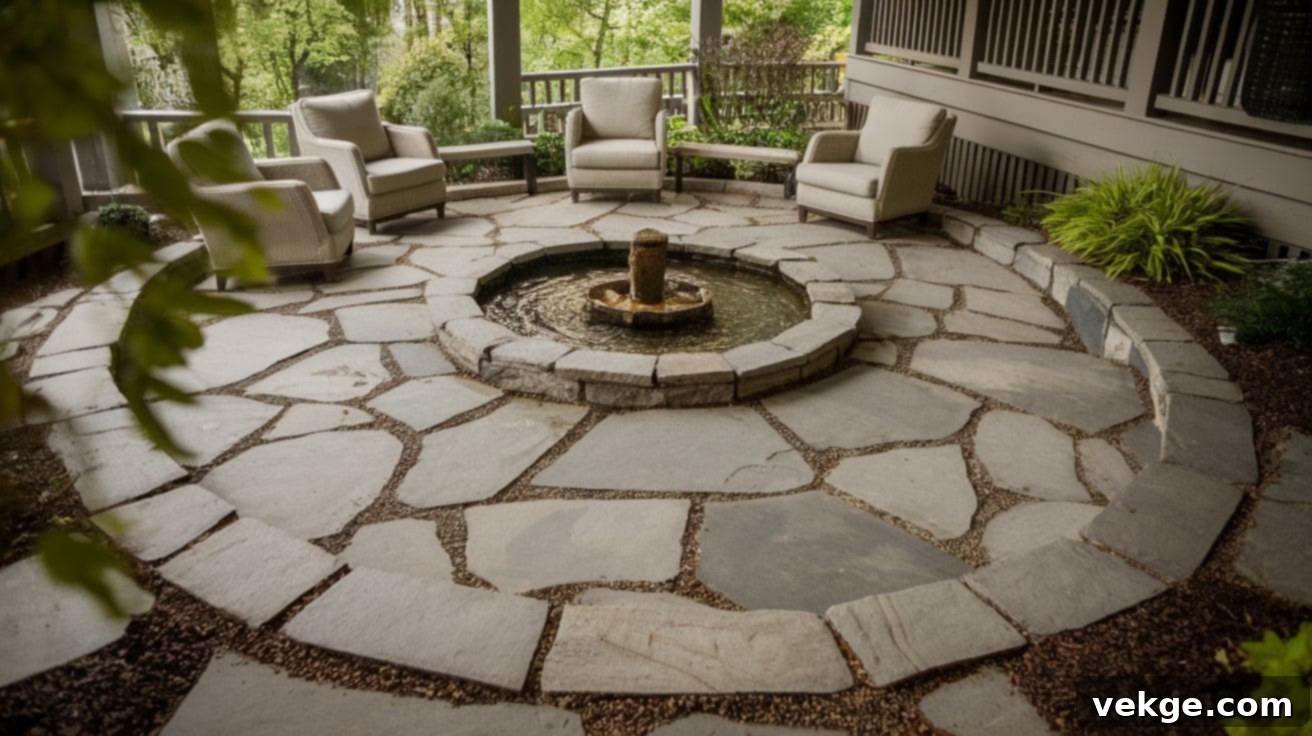
For a porch that encourages intimate conversations and relaxed gatherings, consider a circular flagstone patio design. The gentle, rounded lines of a circular pattern soften the overall aesthetic, while the natural texture of flagstone adds rustic charm. This layout is perfect for defining a distinct seating area, making your porch feel exceptionally inviting and setting the stage for memorable outdoor moments, creating a cozy nook for relaxation or entertainment.
9. Classic Stone and Brick Combination

Achieve a timeless and deeply characterful look by combining the enduring appeal of natural stone with the classic warmth of brick. This combination introduces varied textures and colors, creating a rich visual tapestry that enhances architectural interest. Whether used for pillars, foundations, or decorative accents, the blend of stone’s ruggedness and brick’s traditional charm results in a porch that feels both established and inviting, offering a truly harmonious aesthetic that is rich in texture and history.
10. Covered Stone Porch for All-Weather Enjoyment
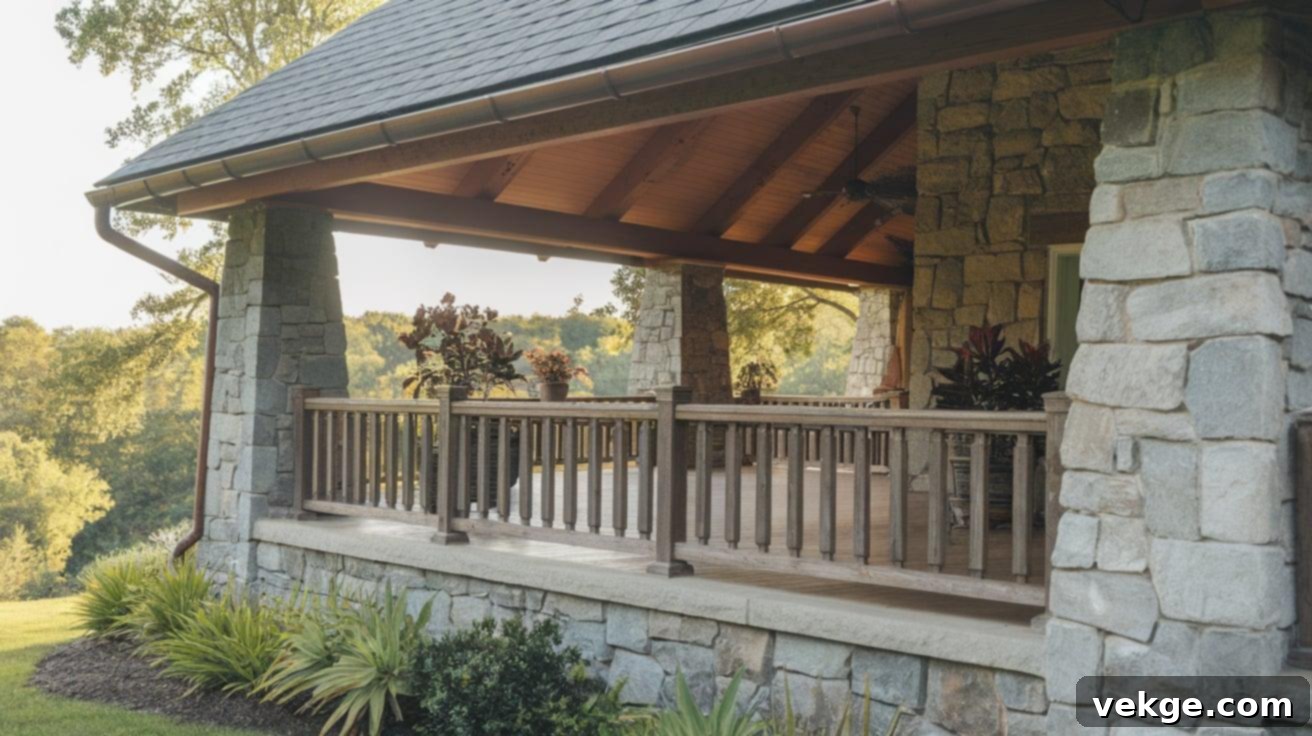
Extend your outdoor living season with a covered stone porch. By building a solid stone foundation and flooring, then adding a protective roof structure, you create a versatile outdoor room that can be enjoyed regardless of sun or light rain. This design offers shade, shelter, and a comfortable space for relaxation or entertaining, while the enduring beauty of the stone ensures it remains a stylish and highly functional extension of your home, providing comfort and protection year-round.
11. Charming Cottage-Style Stone Porch

Evoke a sense of cozy charm and historical appeal with a cottage-style stone porch. This inviting design typically features natural, softer-hued stones like grey flagstone for the flooring, complemented by low-profile limestone or fieldstone walls. Architectural details often include sturdy stone columns supporting a welcoming wooden roof extension, providing both shade and a quintessential rustic aesthetic. This style creates a warm, approachable entrance that feels timeless and deeply rooted, inviting visitors with its understated elegance.
12. Vibrant Colored Stone Accents
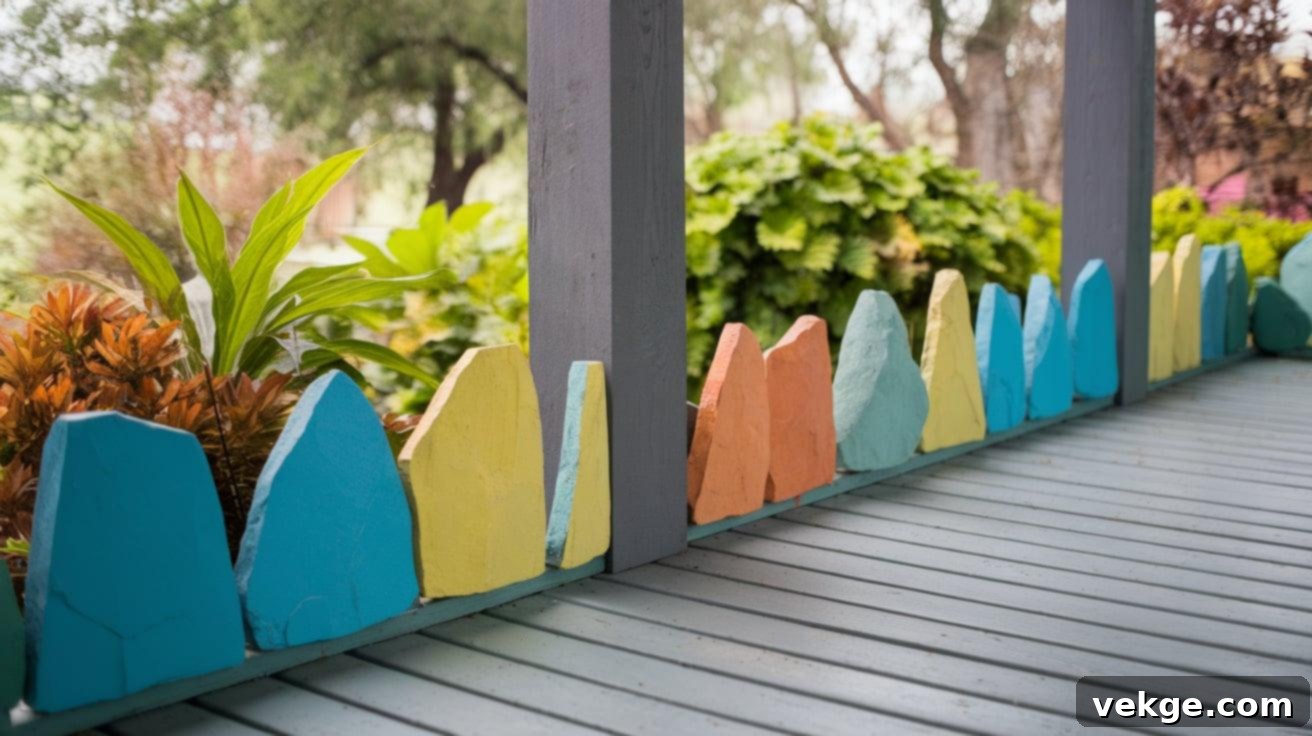
Inject a unique burst of personality and artistic flair into your porch by incorporating vibrant colored stone accents. This can involve using stones with natural hues of red, blue, green, or gold in a mosaic pattern, as border elements, or for specific decorative features. It’s a dynamic way to break up monochrome schemes, create visual interest, and reflect your individual style, making your porch truly stand out with playful elegance and a touch of bespoke craftsmanship.
How to Choose the Right Stone for Your Front Porch: A Comprehensive Guide
Selecting the perfect stone for your front porch involves more than just picking a color you like; it’s about harmonizing with your home’s architecture, considering climate, budget, and desired maintenance. A thoughtful choice will ensure your porch is not only beautiful but also functional and long-lasting. To guide your decision, focus on these critical factors:
1. Architectural Style and Aesthetic Harmony
Your home’s existing architectural style should heavily influence your stone choice. A rustic farmhouse might pair beautifully with irregular flagstone or natural fieldstone, enhancing its organic charm. A modern minimalist home, on the other hand, would benefit from the clean lines and polished surface of granite or a sleek, contemporary stone veneer. For traditional or Mediterranean homes, limestone or cut stone often provide the classic elegance desired. Consider the overall “mood” you wish to create: warm and inviting, grand and formal, or chic and contemporary. The goal is to select a stone that feels like an extension of your home, not an afterthought.
2. Stone Type Characteristics (Durability, Texture, Color)
- Durability: Think about the local climate and foot traffic. Granite is exceptionally hard-wearing for harsh winters or high-traffic areas due to its density and resistance to abrasion. Flagstone and limestone are also durable but, being more porous, may require more regular sealing, especially in regions with freeze-thaw cycles, to prevent damage and water absorption.
- Texture: The texture of the stone plays a huge role in the final look and feel, as well as safety. Smooth, polished stones like granite offer a refined touch but can be slippery when wet. Rugged, irregular flagstone creates a natural, inherently slip-resistant surface. Stacked or dry-stacked stone adds significant three-dimensional texture to vertical elements like columns or walls, providing visual interest and tactile appeal.
- Color: Stone colors range widely from earthy browns and reds to cool grays and pristine whites. Light-colored stones can make a smaller porch feel more expansive and reflect sunlight, keeping the area cooler during hot months. Darker stones can create a dramatic statement and absorb heat, which can be a benefit in colder climates. Aim for colors that either complement your home’s exterior palette (e.g., roof, siding, trim) or provide a pleasing, intentional contrast that enhances the overall design.
3. Size and Layout of Stones
The size and pattern of the stones contribute significantly to the perceived scale and formality of your porch. Large, broad stones create a stately and grand impression, ideal for spacious porches, giving a sense of solidity and permanence. Smaller, more intricate patterns, such as those found in mosaics or precise cuts, can add detail and work well in more compact areas, lending a refined touch. For flooring, consider a consistent, rectilinear pattern for a formal look or a random, organic layout for a rustic feel. For vertical applications like columns or accent walls, a uniform stacked stone creates strong visual interest, while ledgestone offers a flatter, naturally layered effect.
4. Budget Considerations
Stone comes at various price points, which is a crucial factor for most homeowners. Natural, solid stone like granite or custom-cut flagstone can be a significant investment due to material costs and specialized installation requirements. Stone veneer offers a more budget-friendly alternative that still delivers an authentic look without compromising on aesthetic appeal, as it is lighter and often easier to install. Always factor in installation costs, which can vary based on the complexity of the design, the type of stone chosen, and whether you opt for professional installation or a DIY approach.
5. Maintenance Requirements and Climate Suitability
Some stones are more porous than others, affecting their sealing and cleaning needs. Granite is relatively low maintenance, requiring less frequent sealing due to its dense nature. In contrast, limestone and flagstone are more porous and may require more regular sealing to prevent staining, moss growth, and damage from freeze-thaw cycles. Understanding the long-term care commitment for your chosen stone will help ensure its beauty endures without unexpected hassle. Furthermore, consider how well the stone will perform in your specific climate – its slip resistance when wet, its ability to withstand extreme temperatures, and its susceptibility to efflorescence (salt deposits).
By carefully evaluating these aspects—your home’s style, the inherent qualities of the stone, the desired scale, your budget, and maintenance expectations—you can confidently select the perfect stone to create an inviting and stunning front porch that truly enhances your home for years to come.
Maintaining Your Stone Front Porch: Tips for Lasting Beauty
A beautifully designed stone front porch is an investment, and proper maintenance is crucial to preserving its aesthetic appeal and structural integrity for decades. While stone is inherently durable, regular care will prevent damage, maintain its natural luster, and ensure it continues to be a welcoming feature of your home.
General Cleaning and Sealing Practices
- Regular Sweeping and Rinsing: The simplest yet most effective maintenance step is routine cleaning. Regularly sweep away loose dirt, leaves, pine needles, and other debris. A quick rinse with a garden hose can prevent grime from settling into the stone’s pores, especially after heavy rains or windy days, which reduces the need for more intensive cleaning later.
- Deep Cleaning: For deeper cleaning, especially for porous stones, use a mild, pH-neutral stone cleaner diluted in water. Always follow the manufacturer’s instructions for concentration. Avoid harsh chemicals, acidic cleaners (like vinegar), or abrasive brushes, as these can damage the stone’s surface, strip away sealants, or etch the material. A soft-bristle brush, mop, or even a pressure washer set to a low, gentle setting is usually sufficient to remove stubborn dirt and mildew.
- Sealing: Sealing is paramount for most natural stones to protect against moisture penetration, staining, and erosion. The frequency of sealing depends on the stone’s porosity and exposure to the elements.
- Flagstone and Limestone: These porous stones are highly susceptible to moisture absorption and staining. They should generally be sealed every 1–2 years with a high-quality impregnating sealer. This creates a barrier against water, oil, and organic growth, making them easier to clean and preserving their natural color and integrity.
- Granite and Slate: While denser and less porous than other stones, granite and slate can still benefit from sealing every 2–3 years to maintain their natural shine and enhance their stain resistance. This is particularly important in areas prone to spills (e.g., from grilling) or heavy foot traffic, protecting their polished or honed finishes.
- Stone Veneer: Though often made of manufactured concrete or thinner slices of natural stone, an application of a high-quality breathable sealant every 2–3 years can extend its life and protect against discoloration, moisture ingress, and the effects of weathering, ensuring the veneer maintains its authentic appearance.
Seasonal Care Considerations
- Winter Care: Freezing and thawing cycles can be particularly harsh on stone, causing cracks or spalling. Avoid using de-icing salts (sodium chloride or calcium chloride) directly on your stone porch, as they can cause pitting, discoloration, and accelerate erosion of the stone’s surface and mortar joints. Instead, opt for sand, non-clumping cat litter, or specialized stone-safe ice melts (typically containing magnesium chloride or calcium magnesium acetate) for traction. Promptly remove snow and ice to minimize prolonged moisture exposure and potential freeze damage.
- Spring and Summer Care: As the weather warms, perform a thorough deep clean to remove any accumulated organic debris, such as moss, mildew, or algae, which can thrive in damp, shaded conditions. Inspect your sealant and reapply if water no longer beads on the surface (a simple water droplet test can confirm this). Ensure proper drainage around the porch to prevent standing water, which can lead to moisture damage and insect breeding grounds. Trim overhanging branches to reduce debris fall and provide more sunlight to help keep the stone dry.
- Fall Care: The most crucial task in fall is to diligently remove fallen leaves, acorns, and other organic debris. Allowing leaves to decompose on your stone porch can lead to stubborn tanic acid stains, especially on lighter-colored or unsealed stones, and can trap moisture, promoting mold and mildew growth. Regular sweeping or using a leaf blower will keep your porch clean and prevent these issues.
By adhering to a consistent maintenance routine tailored to your specific stone type and local climate, your front porch will remain a stunning and durable feature, offering a warm welcome and enhancing your home’s appeal for many years to come.
Conclusion: Your Dream Stone Front Porch Awaits
As we’ve explored, a thoughtfully designed stone front porch is much more than just an entryway; it’s a significant enhancement to your home’s character, functionality, and curb appeal. From the rustic charm of flagstone to the modern elegance of granite, the versatility of natural stone offers endless possibilities to create a welcoming and durable outdoor space that perfectly reflects your personal style and complements your home’s unique architecture.
Remember to consider the key elements during your planning phase: the specific type of stone, its color, texture, and pattern, how it integrates with pillars, steps, and pathways, and the enhancing touches of lighting, furniture, and landscaping. Each decision contributes to the overall ambiance, ensuring your porch feels cohesive and inviting. Furthermore, a commitment to regular, appropriate maintenance will safeguard your investment, preserving the beauty and longevity of your stone porch through every season and ensuring it remains a source of pride for years.
Armed with these comprehensive stone front porch ideas and practical tips, you are now well-equipped to embark on your porch transformation project. Take your time, draw inspiration from the designs that resonate most with you, and plan each step carefully. The result will be a stunning, enduring, and deeply welcoming entrance that you and your guests will admire for years to come. Your home’s transformation into a true outdoor sanctuary begins at the front door!
Eager for more home improvement inspiration? Continue exploring our extensive collection of design guides and practical tips to elevate every corner of your living space and maximize your home’s potential.
